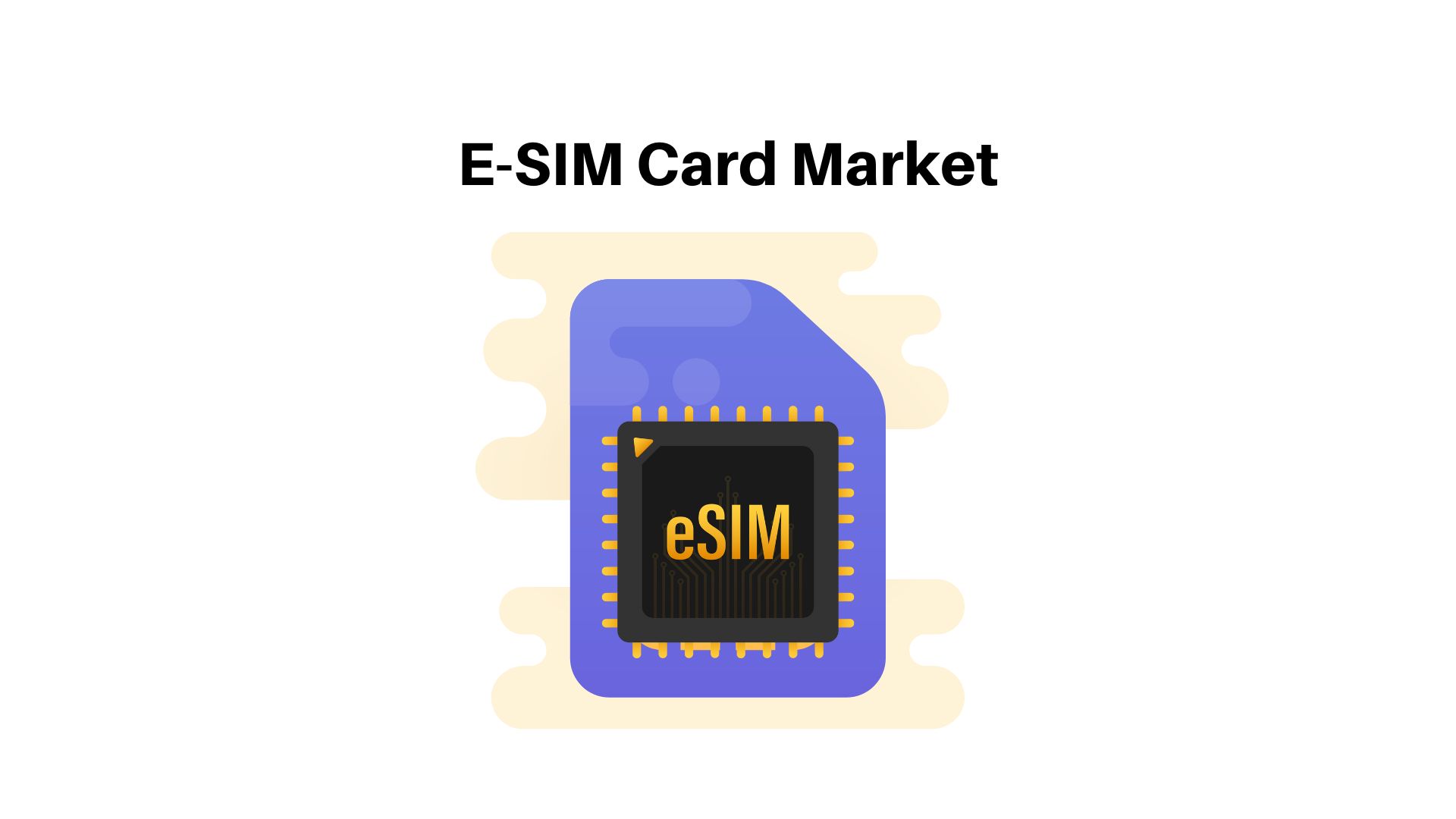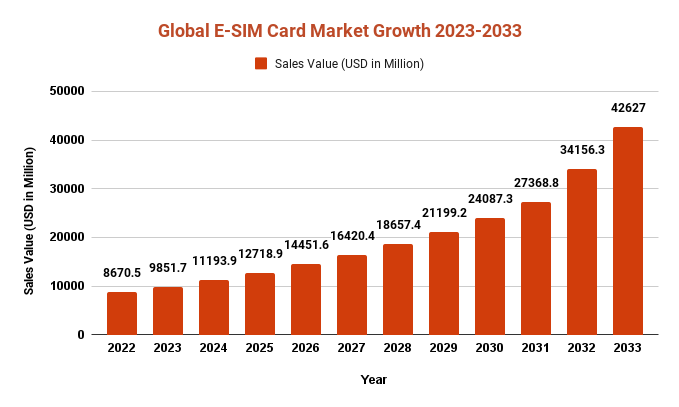eSIM Card Market Intelligence Report 2023-2033, Growth rate (CAGR) of 13.49%

Page Contents
Market Overview
Published Via 11Press: eSIM Card Market: An eSIM card, also known as an “Embedded Subscriber Identity Module,” is a digital SIM card embedded within a mobile device. Unlike traditional SIMs, there's no physical card to insert into the phone; rather, the eSIM card is embedded into the hardware and activated remotely through software. As more mobile users switch carriers or plans with an eSIM rather than physically changing out SIMs, this convenience becomes even greater for frequent travelers or those wanting to switch between different service providers or plans.
“The Global eSIM Card market size is forecast to reach USD 42627 million by 2033 from USD 8670.5 million in 2022, expanding at a compound annual growth rate (CAGR) of 13.49% from 2021-2031.”
eSIMs are more secure than traditional SIM cards, as they utilize encryption to safeguard user data. Furthermore, eSIMs offer additional benefits like the capacity for multiple profiles and remote provisioning – enabling faster activation and deployment of devices. Nevertheless, not all mobile carriers support eSIMs, nor are all devices eSIM-compatible; so before trying to use an eSIM it's essential that you consult your carrier and device manufacturer first.

Key Takeaways
- The eSIM Card market expected to reach USD 8670.5 million in 2022.
- Forecasted compound annual growth rates between 2022 and 2032 is 13.49%.
- By 2033, the eSIM Card market is projected to reach USD 42627 Million.
- eSIM cards are digital SIM cards embedded in mobile devices that don't need physical insertion into a device and can be activated remotely through software.
- eSIMs are more convenient than traditional SIM cards for frequent travelers or those wishing to switch between different carriers or plans.
- They provide additional advantages such as improved security, the capacity to store multiple profiles, and support for remote provisioning.
- Not all mobile carriers support eSIMs, and not all devices are eSIM-compatible.
- It is therefore essential to consult your carrier and device manufacturer prior to using an eSIM.
Click Here To Access Sample Pages Of This Report: https://marketresearch.biz/report/e-sim-card-market/request-sample/
Regional Snapshot
North America
- eSIM adoption in North America is on the rise, though not yet available from all carriers.
- Major American carriers such as AT&T, Verizon and T-Mobile provide eSIM support through an eSIM card for select devices.
- Canada has been slower to embrace eSIM technology than other countries, and only a few carriers provide support for it.
Europe:
- eSIM adoption in Europe continues to rise as more carriers offer it.
- In some European countries such as Germany, eSIM technology is becoming more widely adopted by device manufacturers and carriers.
Asia-Pacific:
- This region has seen an exponential rise in eSIM adoption, with many carriers actively supporting it.
- China is a major hub for eSIM technology. There are plenty of local carriers that service both domestic and international customers alike.
Middle East and Africa:
- Only a few carriers offer this cutting-edge mobile payment system in Africa and the Middle East.
- This technology is rapidly gaining traction and is expected to expand in the future.
Latin America
- Latin America's eSIM adoption is still in its early stages, with only a few carriers supporting it.
- Asia Pacific is expected to witness a meteoric rise in eSIM adoption over the coming years.
Enquire Here & Query for report: https://marketresearch.biz/report/e-sim-card-market/#inquiry
Drivers
With eSIMs, users can switch carriers or plans without physically swapping out SIM cards – making it ideal for frequent travelers or those wanting to switch between different carriers or plans. ESIM technology can help consumers and carriers save costs by forgoing physical SIM cards, eliminating inventory management expenses and streamlining distribution processes. Furthermore, eSIMs are more secure than traditional SIMs since they utilize encryption to safeguard user data. This is especially pertinent for frequent travelers and those at greater risk of cyber attacks. eSIMs provide support for remote provisioning, which enables quicker activation and deployment of devices – ideal for enterprises and organizations needing to deploy large numbers of units quickly and efficiently.
eSIMs can store multiple profiles, enabling users to switch between different carriers or plans on the same device. This is useful for individuals who require separate profiles for work and personal use or international travelers requiring to switch between local networks. With eSIM technology, users can activate temporary plans when traveling abroad without needing to purchase a new physical SIM card or switch SIM cards. This simplifies the roaming experience and allows users to use their devices more conveniently while away. eSIM technology offers enhanced security features, such as tamper-resistant chips and remote management capabilities, which can protect user data and prevent fraudulence. This provides users with greater assurance when using their mobile devices.
Restraints
Not all devices are eSIM-compatible, so users may need to purchase new devices that support this technology. Not all mobile carriers provide eSIM support, leaving users limited in their carrier choices if they wish to utilize eSIM technology. Furthermore, some countries have regulations which limit its usage which may limit adoption there. Lastly, there may be additional costs associated with implementing eSIM technology such as upgrading existing systems and training staff on its use.
Opportunities
eSIM technology makes it simple for users to switch between carriers and plans, increasing competition and driving down prices. Switching between different plans on one device gives users more flexibility and control over their mobile services. eSIM simplifies activation processes for mobile devices, making it faster and simpler for individuals to get started with their devices.
eSIM technology opens up new business models such as pay-as-you-go plans that are both flexible and cost-effective for consumers. It also enables new IoT and M2M applications, like remote monitoring of devices without physical SIM cards needed. Furthermore, eSIM simplifies international roaming processes so users can use their devices while traveling abroad more conveniently at lower costs. eSIM presents several opportunities for the mobile industry such as increased competition, greater flexibility, improved user experience, new business models, IoT/M applications, etc.
Latest Version Of eSIM Market Report Purchase Market Report
Challenges
Unfortunately, there is currently no global standard for eSIM technology, making it challenging for carriers and device manufacturers to create interoperable solutions. To take advantage of eSIM, devices must have the required hardware and software support; unfortunately, not all are capable of supporting this protocol. This can restrict the number of devices that can use eSIM technology. Furthermore, eSIM requires transmitting sensitive information like encryption keys, which could be vulnerable to security breaches. Some countries have regulations that limit the use of eSIMs, potentially hindering their adoption in those areas. Carriers may need to rethink their business models due to this technology's introduction; this can be difficult and require significant investments in infrastructure. Furthermore, many consumers are still unfamiliar with eSIM technology and its potential advantages.
These challenges are impeding the widespread adoption and implementation of eSIM technology. Nonetheless, as industry efforts to address these obstacles and standards are established, eSIM usage should become more widespread within mobile ecosystems.
Market Segmentation
By Application
1. Machine to Machine (M2M)
- Connected Cars
- Utility
- Others
2. Wearable & Companion Devices
3. Smartphones
4. Tablets & Laptops
By type:
- MFF2 eSIM
- MFF2 Industrial eSIM
- Embedded SIM.
Key Players
- Apple Inc.
- Samsung
- Gemalto NV
- Giesecke & Devrient GmbH
- NTT DOCOMO, Inc.
- OT-Morpho
- Telef?nica S.A.
- Deutsche Telekom AG
- Sierra Wireless, Inc. and STMicroelectronics
Report Scope
| Report Attribute | Details |
| Market size value in 2022 | USD 8670.5 million |
| Revenue forecast by 2033 | USD 42627 million |
| Growth Rate | CAGR Of 13.49% |
| Regions Covered | North America, Europe, Asia Pacific, Latin America, and Middle East & Africa, and Rest of the World |
| Historical Years | 2017-2022 |
| Base Year | 2022 |
| Estimated Year | 2023 |
| Short-Term Projection Year | 2028 |
| Long-Term Projected Year | 2033 |
Recent Developments
Apple is a leader in the adoption and use of eSIM technology, recently expanding support for its iPhone 13 models to make switching carriers easier. As more devices feature eSIMs, eSIM technology is becoming increasingly popular within the IoT sector – enabling remote monitoring and control from anywhere. Countries around the world are encouraging this innovation by providing regulatory incentives that could accelerate its adoption. To expand eSIM support, mobile network operators and technology companies have formed new partnerships. eSIM technology has been explored for various use cases such as digital identity solutions utilizing eSIMs and connected vehicle applications. These developments demonstrate that eSIM technology is on the rise and expected to keep expanding over the coming years.
Devices and Services That Currently Use eSIM Technology
- All iPhone models, including the iPhone XS Max and iPhone XS, now support eSIM support. This enables users to activate a second line of service without needing a physical SIM card.
- Pixel smartphones, such as the Pixel 2, Pixel 3 XL and Pixel 3 XL all offer eSIM support to enable users to activate a second line of service without using physical SIM cards.
- Samsung's most recent Galaxy smartphones (Galaxy S20/S21, Note20, Note20, and Z Fold2) come with eSIM support, allowing users to activate a second phone line without the need for a physical SIM card.
- The Microsoft Surface Pro LTE offers eSIM support, enabling users to activate a mobile plan without requiring physical SIM cards.
- Google Fi, an MVNO, utilizes eSIM technology and allows customers to choose between Sprint (T-Mobile) and US Cellular (US Cellular), depending on which network offers the strongest signal.
- Truphone, a leading global mobile network operator, offers eSIM plans to international travelers. This enables them to use their phones across over 190 countries without needing to swap SIM cards.
With the rise in eSIM adoption, more devices and services will begin utilizing this technology.
FAQ.
An eSIM, also known as an embedded SIM, is a digital SIM card located within a device like a smartphone or smartwatch which enables users to activate cellular service without having to physically insert a physical SIM card.
A physical SIM card is a small, removable card that must be inserted into an electronic device's SIM card slot; on the other hand, an eSIM chip is embedded within the hardware of that same device.
eSIMs make it simple to switch between carriers and plans without physically replacing a SIM card. Users can activate a new plan by simply scanning a QR code or entering an activation code - especially convenient for frequent travelers.
eSIMs make it simpler for users to switch carriers and plans without physically replacing a SIM card, which has led to an uptick in demand for eSIM-enabled devices and plans.
Mobile network operators (MNOs) and technology firms can collaborate in several ways to take advantage of eSIM technology and fuel growth within the mobile industry.
eSIM technology offers remote provisioning of IoT devices, making it simpler to deploy and manage large numbers of units. This reduces both time and cost associated with deploying such systems.
eSIMs enable remote provisioning and management of devices, eliminating the need for manual intervention and cutting operational costs.
The team behind market.us, marketresearch.biz, market.biz and more. Our purpose is to keep our customers ahead of the game with regard to the markets. They may fluctuate up or down, but we will help you to stay ahead of the curve in these market fluctuations. Our consistent growth and ability to deliver in-depth analyses and market insight has engaged genuine market players. They have faith in us to offer the data and information they require to make balanced and decisive marketing decisions.



